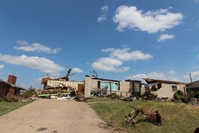While natural disasters are a common occurrence in the United States and around the world, there have been times where storm systems develop earlier or later than residents are expecting.
Such a situation happened in the Midwest on November 17, where residents as far as Iowa and Michigan had to be on alert, according to the Huffington Post. The weather front was filled with strong winds and hail—when combined with 60-70 degree weather, it had the potential to cause havoc.
"You don't need temperatures in the 80s and 90s to produce severe weather [because] the strong winds compensate for the lack of heating," Matt Friedlein, a meteorologist with the National Weather Service told the Associated Press. "That sets the stage for what we call wind shear, which may produce tornadoes."
Confirmation for such a system passing through the region came to light Saturday at the Storm Prediction Center in Norman, Oklahoma, Fox News reported. Once Sunday got around, residents were aware of the circumstances and prepared to take cover. To play it safe, text alerts and weather warnings went off again late Sunday morning.
In Washington, Illinois, pastor David Bennett told Fox News that phones began going off during his service as people began to receive alerts about the storm's path.
"I'd say probably two dozen phones started going off in the service, and everybody started looking down," Bennett said.
This warning and many others greatly benefited Illinois area residents because the storm took eight lives, only one death in Washington, which ended up taking the biggest blow from the storm. Without the support of local news and radio stations, more lives could have been at risk.
Having a comprehensive communication strategy is one of many aspects of a continuity of operations plan. Local officials and residents who are aware of their roles ahead of time can greatly reduce their likelihood of being in danger. Business continuity consultants can help cities and towns develop their own action plans.

